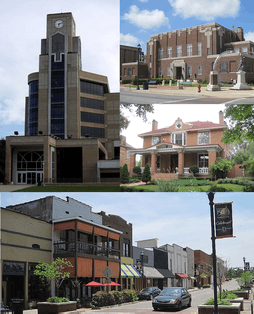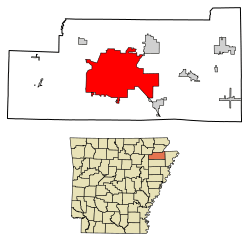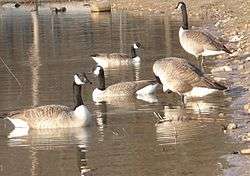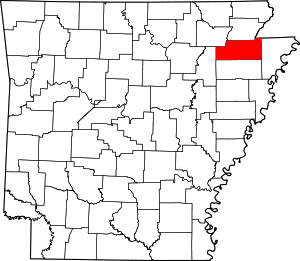Jonesboro, Arkansas
Jonesboro is a city located on Crowley's Ridge in the northeastern corner of the U.S. State of Arkansas. Jonesboro is one of two county seats of Craighead County. According to the 2010 Census,[3] the city had a population of 67,263 and is the fifth-largest city in Arkansas. In 2010, the Jonesboro metropolitan area had a population of 121,026[4] and a population of 163,116 in the Jonesboro-Paragould Combined Statistical Area.[5]
Jonesboro, Arkansas | |
|---|---|
 Clockwise from top: Craighead County Courthouse, a house in the West Washington Avenue Historic District, downtown Jonesboro, and the Dean B. Ellis Library at Arkansas State University | |
 Seal | |
| Nickname(s): J-boro, J-boog, J-Town, JB | |
| Motto(s): People, Pride, Progress | |
 Location of Jonesboro in Craighead County, Arkansas. | |
 Jonesboro, Arkansas Location in the United States | |
| Coordinates: 35°49′41″N 90°41′39″W | |
| Country | |
| State | |
| County | Craighead |
| Incorporated | February 19, 1859 |
| Government | |
| • Mayor | Harold Perrin |
| Area | |
| • City | 80.73 sq mi (209.09 km2) |
| • Land | 80.17 sq mi (207.64 km2) |
| • Water | 0.56 sq mi (1.45 km2) |
| Elevation | 259 ft (79 m) |
| Population (2010) | |
| • City | 67,263 |
| • Estimate (2019)[2] | 78,394 |
| • Density | 977.83/sq mi (377.54/km2) |
| • Metro | 124,042 |
| Time zone | UTC−06:00 (CST) |
| • Summer (DST) | UTC−05:00 (CDT) |
| ZIP Codes | 72401-72405 |
| Area code(s) | 870 |
| FIPS code | 05-35710 |
| GNIS feature ID | 0077389 |
| Website | jonesboro.org |
Jonesboro is the home to Arkansas State University and the cultural and economic center of Northeast Arkansas.
History
The Jonesboro area was first inhabited for thousands of years by indigenous peoples. At the time of European encounter, historic tribes included the Osage, the Caddo, and the Quapaw.[6] The name of the state of Arkansas comes from the Quapaw language.[6] French and Spanish traders and trappers had relations with these groups.
After the United States acquired this territory in the Louisiana Purchase of 1803, American settlers eventually made their way to the area where Jonesboro is located. They began exploring, hunting, trapping, and trading with the local Indian tribes. A permanent settlement of Jonesboro was set up shortly after 1815.
In 1859, land was taken from nearby Greene, Mississippi, and Poinsett counties and was used to form Craighead County. Jonesboro was designated as the original county seat. As the population increased in the west of the county, Lake City was named as the second seat.[7] Jonesboro had 150 residents in 1859. It was named after State Senator William A. Jones[8] in recognition of his support for the formation of Craighead County. Originally spelled Jonesborough, the city name was later shortened to its present-day spelling.
During the late 19th century, the city tried to develop its court system and downtown infrastructure. Shortly after the city was named county seat, the highest point in Jonesboro was identified and a courthouse was planned for construction. This was delayed for several years, for the locals did not want to ruin their deer hunting. The first courthouse was finally completed but was destroyed by a fire in 1869. A store across from this site was rented and used as a courthouse. It was destroyed in an 1876 fire. Another building was constructed on the same site, but it fell to a fire in 1878, a major one that destroyed most of downtown Jonesboro. Soon afterward, another courthouse was constructed; it was replaced by the present courthouse in 1934.
The St. Louis Southwestern Railway, known as the Cotton Belt Railroad was constructed through Jonesboro, with its tracks passing just north of the center of the city. During the first train's journey, it became stuck and supplies had to be carried into town.[6] It connected St. Louis to points in Arkansas and Texas. Other major railways began to construct tracks to and from Jonesboro, including the St. Louis–San Francisco Railway and Missouri Pacific Railroad. Some of the rail companies still own and use the tracks that run through Jonesboro.
The city set up the Jonesboro School District in 1899.[9] In 1900, St. Bernard's Regional Medical Center was established by the Olivetan Benedictine Sisters.[10] The Grand Leader Department Store, the first department store in the city, was opened in 1900. Woodland College and two schools within the Jonesboro School District were opened in 1904. Arkansas State College (now Arkansas State University) was established in 1909,[11] a year in which the first horseless carriages were driven in the city. There is a recording on a Sanborn Fire Insurance Map dating back to March 1897 of a Presbyterian Church existing at the corner of Church St. and Monroe, and a Christian church located at the corner of Union and Huntington Ave. Other early churches of the city were started in the 1910s. First Baptist Church was founded in 1911, and First Methodist Church in 1916.
On September 10, 1931, Governor Harvey Parnell authorized the Arkansas National Guard to be deployed in Jonesboro to quell the Church War, a clash between the followers of Joe Jeffers and Dow H. Heard, the pastor of the First Baptist Church of Jonesboro. Jeffers' supporters also attacked the mayor and police chief, resulting in front-page coverage of the incident in The New York Times.
The Jonesboro Lynching of 1881 took place at midnight on March 12. The Decatur Daily Republican reported that four black men—Green Harris (sometimes referred to as Hawes), Giles Peck, John Woods (sometimes referred to as Jud Woods), and Burt Hoskins (sometimes referred to as Haskins)—had been arrested and tried before magistrates Jackson and Akers at New Haven Church, eight miles north of Jonesboro. The hearing, which found that the men were guilty, was attended by several hundred people. According to this and several other reports, the accused made a complete confession. The magistrates bound them over to the grand jury, and they were ordered taken to the jail in Jonesboro. The hour being late, however, it was decided to hold them overnight in the church under a strong guard. The large crowd gradually dispersed, "muttering threats of vengeance."
Around midnight, between 200 and 300 masked men surrounded the church, overpowered the guards, and broke in the doors and windows. They seized the accused, dragged them to a tree about 200 yards away, and hanged them. Once again, the crowd dispersed, "leaving the bodies of their victims dangling in the air and presenting a horrible spectacle in the moonlight." According to the Republican, "The crime and punishment form one of the blackest pages in the annals of the state."Encyclopedia of Arkansas
On May 15, 1968 an F4 tornado struck Jonesboro, destroying 164 homes.[12]
The Westside Middle School massacre occurred on March 24, 1998. Two young boys (aged 11 and 13 years) fired upon students at Westside Middle School while hidden in woodlands near the school. They killed four students and one teacher, and injured 10 persons.[13]
In the 2007–2008 school year the Jonesboro Public School District elementary schools were reclassified as magnet schools.[14]
2020 tornado
A "large, destructive" EF3 tornado struck Jonesboro on March 28, 2020, causing severe damage to a shopping mall and at least twenty minor injuries, and two severe injuries.[15]
Geography
Jonesboro is located at 35°49′41″N 90°41′39″W (35.828067, -90.694048)[16] atop Crowley's Ridge in northeastern Arkansas.
According to the United States Census Bureau, the city has a total area of 80.5 square miles (208.4 km2), of which 79.9 square miles (206.9 km2) is land and 0.58 square miles (1.5 km2), or 0.72%, is water.[3]
Climate
Jonesboro has a humid subtropical climate (Köppen climate classification Cfa).
| Climate data for Jonesboro, AR (1981–2010 normals, extremes 1890–present) | |||||||||||||
|---|---|---|---|---|---|---|---|---|---|---|---|---|---|
| Month | Jan | Feb | Mar | Apr | May | Jun | Jul | Aug | Sep | Oct | Nov | Dec | Year |
| Record high °F (°C) | 90 (32) |
83 (28) |
95 (35) |
96 (36) |
101 (38) |
110 (43) |
116 (47) |
111 (44) |
110 (43) |
98 (37) |
88 (31) |
79 (26) |
116 (47) |
| Mean maximum °F (°C) | 66.3 (19.1) |
71.0 (21.7) |
78.3 (25.7) |
84.0 (28.9) |
90.1 (32.3) |
96.9 (36.1) |
98.3 (36.8) |
98.5 (36.9) |
93.5 (34.2) |
86.7 (30.4) |
77.4 (25.2) |
67.1 (19.5) |
100.4 (38.0) |
| Average high °F (°C) | 47.0 (8.3) |
51.7 (10.9) |
61.2 (16.2) |
71.8 (22.1) |
80.4 (26.9) |
88.8 (31.6) |
91.1 (32.8) |
90.4 (32.4) |
83.9 (28.8) |
73.1 (22.8) |
60.1 (15.6) |
48.5 (9.2) |
71.8 (22.1) |
| Daily mean °F (°C) | 38.5 (3.6) |
42.5 (5.8) |
50.8 (10.4) |
61.0 (16.1) |
69.7 (20.9) |
78.1 (25.6) |
81.1 (27.3) |
80.0 (26.7) |
72.8 (22.7) |
61.4 (16.3) |
50.4 (10.2) |
39.9 (4.4) |
62.0 (16.7) |
| Average low °F (°C) | 29.0 (−1.7) |
33.1 (0.6) |
40.7 (4.8) |
49.8 (9.9) |
58.7 (14.8) |
67.3 (19.6) |
71.2 (21.8) |
69.6 (20.9) |
61.5 (16.4) |
50.2 (10.1) |
40.4 (4.7) |
31.5 (−0.3) |
50.3 (10.2) |
| Mean minimum °F (°C) | 10.6 (−11.9) |
15.6 (−9.1) |
23.5 (−4.7) |
33.6 (0.9) |
45.2 (7.3) |
56.1 (13.4) |
61.7 (16.5) |
59.9 (15.5) |
46.1 (7.8) |
33.9 (1.1) |
24.8 (−4.0) |
13.9 (−10.1) |
5.9 (−14.5) |
| Record low °F (°C) | −18 (−28) |
−13 (−25) |
1 (−17) |
26 (−3) |
32 (0) |
41 (5) |
50 (10) |
45 (7) |
33 (1) |
21 (−6) |
9 (−13) |
−7 (−22) |
−18 (−28) |
| Average precipitation inches (mm) | 3.42 (87) |
3.60 (91) |
4.09 (104) |
4.82 (122) |
4.76 (121) |
3.09 (78) |
3.28 (83) |
2.70 (69) |
3.01 (76) |
4.46 (113) |
4.69 (119) |
4.53 (115) |
44.42 (1,128) |
| Average snowfall inches (cm) | 3.5 (8.9) |
1.9 (4.8) |
0.6 (1.5) |
0.0 (0.0) |
0.0 (0.0) |
0.0 (0.0) |
0.0 (0.0) |
0.0 (0.0) |
0.0 (0.0) |
0.0 (0.0) |
0.0 (0.0) |
0.4 (1.0) |
2.9 (7.4) |
| Average precipitation days (≥ 0.01 in.) | 8.4 | 8.2 | 9.1 | 8.6 | 10.1 | 6.9 | 7.6 | 5.6 | 6.3 | 8.0 | 8.8 | 8.9 | 93.2 |
| Average snowy days (≥ 0.1 in.) | 1.1 | 0.5 | 0.3 | 0.0 | 0.0 | 0.0 | 0.0 | 0.0 | 0.0 | 0.0 | 0.0 | 0.4 | 1.6 |
| Source: NOAA[17] | |||||||||||||
Demographics
| Historical population | |||
|---|---|---|---|
| Census | Pop. | %± | |
| 1890 | 2,065 | — | |
| 1900 | 4,508 | 118.3% | |
| 1910 | 7,123 | 58.0% | |
| 1920 | 9,384 | 31.7% | |
| 1930 | 10,326 | 10.0% | |
| 1940 | 11,729 | 13.6% | |
| 1950 | 16,310 | 39.1% | |
| 1960 | 21,418 | 31.3% | |
| 1970 | 27,050 | 26.3% | |
| 1980 | 31,530 | 16.6% | |
| 1990 | 46,534 | 47.6% | |
| 2000 | 55,515 | 19.3% | |
| 2010 | 67,263 | 21.2% | |
| Est. 2019 | 78,394 | [2] | 16.5% |
| U.S. Decennial Census[18] | |||

It is the principal city of the Jonesboro, Arkansas Metropolitan Statistical Area.
As of the census[19] of 2013, there were 71,551 people, 26,111 households, and 16,637 families residing in the city. The population density was 697.1 people per square mile (269.1/km2). There were 28,321 housing units at an average density of 304.7 per square mile (117.6/km2). The racial makeup of the city was 74.7% White, 18.4% Black, 0.4% Native American, 1.5% Asian, 0.03% Pacific Islander, 1.0% from other races, and 2.0% from two or more races. 5.2% of the population were Hispanic.
There were 26,111 households, out of which 30.1% had children under the age of 18 living with them, 48.9% were married couples living together, 12.2% had a female householder with no husband present, and 35.4% were non-families. There are 878 unmarried partner households: 776 heterosexual, 50 same-sex male, and 52 same-sex female households. 27.5% of all households were made up of individuals, and 9.0% had someone living alone who was 65 years of age or older. The average household size was 2.47 and the average family size was 2.93.
In the city, the population was spread out, with 22.9% under the age of 18, 16.6% from 18 to 24, 28.1% from 25 to 44, 20.5% from 45 to 64, and 11.8% who were 65 years of age or older. The median age was 32 years. For every 100 females, there were 92.1 males. For every 100 females age 18 and over, there were 88.8 males.
The median income for a household in the city was $32,196, and the median income for a family was $42,082. Males had a median income of $21,633 versus $31,633 for females. The per capita income for the city was $17,884. About 12.9% of families and 23.1% of the population were below the poverty line, including 22.4% of those under age 18 and 12.3% of those age 65 or over.
Points of interest
Craighead Forest Park is a city-owned park located on Crowley's Ridge featuring a 60-acre fishing lake, camping facilities, hiking/biking trails, nature areas, picnic sites and recreational fields.
Crowley's Ridge Parkway runs through Jonesboro. It was designated one of Arkansas' Scenic Byways in 1997, and it was designated Arkansas' first National Scenic Byway in 1998.
In 2004 the Arkansas Game and Fish Commission opened the 160-acre Forrest L. Wood Crowley's Ridge Nature Center in south Jonesboro, adjacent to Craighead Forest Park. The center includes exhibits on the origins and history of the Ridge, wildlife, educational models and displays, land and water features, hiking trails, an observation tower and an auditorium.
Located on the ASU campus, the Arkansas State University Museum is accredited by the American Association of Museums and features 21,000 square feet of historic, archaeological, and natural history exhibits. The museum focuses on the history and cultural heritage of Northeast Arkansas and the Mississippi River Delta region.
Economy

The Mall at Turtle Creek, opened in 2006, is the largest mall in northeast Arkansas. It was the only enclosed mall opened in the United States that year[20] On March 29, 2020, much of the mall was destroyed during an EF-3 tornado. Before the opening of the mall, Indian Mall was the primary shopping destination in northeast Arkansas. In 2012, Indian Mall, named for the former mascot of Arkansas State University, was demolished. The only store to remain in its original location was Sears.
In 2012, Kiplinger's Personal Finance ranked Jonesboro ninth of the "10 Best Cities for Cheapskates".[21]
Education
Higher education
Arkansas State University Is located in Jonesboro.
The North East Arkansas Career & Tech Center[22] is also located in Jonesboro.
Elementary and secondary education
.jpg)
There are six public school districts operating within the city limits of Jonesboro:[23]
Media
| Call Sign | Channel | Network(s) |
|---|---|---|
| KAIT | 8.1 | ABC |
| 8.2 | NBC | |
| 8.3 | CW+ | |
| KTEJ | 19.1 | PBS |
| 19.2 | Create | |
| 19.3 | PBS Kids | |
| 19.4 | World | |
| KJNB-LD/KJNE-LD | 39.1/42.1 | FOX |
| 39.2/42.2 | CBS | |
| 39.3/42.3 | MeTV/MyNetworkTV | |
| KVTJ | 48.1 | Religious |
| Call Sign | Frequency | Format | Branding |
|---|---|---|---|
| KASU | 91.9 | Public Radio | 91.9 KASU |
| K224DW (KDXY-HD3) | 92.7 | Soft AC | EZ 92.7 FM |
| K237FI (KNEA) | 95.3 | Sports | 95.3 The Ticket |
| K253BQ (KJBX-HD2) | 98.5 | Country | 98.5 The Outlaw |
| KEGI | 100.5 | Classic Rock | 100.5 The Eagle Rocks |
| K267AS (KBTM) | 101.3 | News/Talk | News Talk 101.3 KBTM |
| KIYS | 101.7 | Top 40 | 101.7 KISS-FM |
| KLEK-LP | 102.5 | Community | 102.5 KLEK |
| KFLO-LP | 102.9 | 60s, 70s, 80s, and some Hits | KFLO 102.9FM |
| KDXY | 104.9 | Country | 104.9 The Fox |
| KJBX | 106.3 | Hot AC | Mix 106.3 |
| K298AV (KDXY-HD2) | 107.5 | Top 40 | 107.5 The Party Station |
| KFIN | 107.9 | Country | The BIG 107.9 KFIN |
| Call Sign | Frequency | Format | Branding |
|---|---|---|---|
| KNEA | 970 | Sports | 95.3 The Ticket |
| KBTM | 1230 | News/Talk | News Talk 101.3 KBTM |
Transportation
Air Service
The region is served by the Jonesboro Municipal Airport. Scheduled commercial flights between Jonesboro and St. Louis Lambert International Airport, are offered daily by Air Choice One.
Public transport
The city is served by the Jonesboro Economic Transit System (JETS). As of 2011, JETS operates three fixed routes, as well as para-transit service for disabled persons.
List of highways
|
|
Notable people
- Blake Anderson, football head coach, Arkansas State
- David Auburn, playwright and screenwriter, known for award-winning play Proof (and adapted screenplay for film)
- Earl Bell, former pole vault champion and current coach of top US men and women vaulters
- Wes Bentley, actor, known for role as Ricky in American Beauty and American Horror Story
- Jerry Bookout, funeral director and state politician
- Paul Bookout, former state senator for District 21; state Senate President, 2011 to 2013
- Gene Bradley, football player
- Al Bramlet, labor union leader
- Rodger Bumpass, voice of Squidward Tentacles on SpongeBob SquarePants
- Hattie Caraway, first woman elected to United States Senate
- Paul Caraway, son of Hattie Caraway; High Commissioner of United States Civil Administration of the Ryukyu Islands
- Matt Cavenaugh, Broadway actor
- Francis Cherry, Governor of Arkansas from 1953 to 1955
- John Cooper, Republican state senator for District 21 since 2014
- Rick Crawford, U.S. Congressman from Arkansas
- Fred Dreher, football player
- Woody Freeman, businessman; Republican gubernatorial nominee in 1984
- Michelle Gray, state representative since 2013 from Melbourne; former resident of Jonesboro[24]
- John Grisham, best-selling novelist of The Firm, A Time to Kill, The Pelican Brief and more; born in Jonesboro
- Jeff Hartwig, pole vaulter
- Julia Butterfly Hill, environmental activist
- Jon Hubbard, former state representative
- Larry Lacewell, former director of scouting for Dallas Cowboys and adoptive father of Super Bowl champion Barry Switzer's children.
- Jack Ladyman, mechanical engineer and Republican member of Arkansas House of Representatives from a part of Craighead County
- Evan Lindquist, artist and first Artist Laureate of Arkansas
- Kyle Dean Massey, Broadway actor
- Dustin McDaniel, former Arkansas Attorney General
- Ben Murphy, actor, formerly of ABC's Alias Smith and Jones
- Jon Olsen, Olympic gold medalist swimmer
- David Ring, motivational speaker
- Brandt Smith, Republican member of Arkansas House of Representatives for District 58 in Craighead County
- W. Stephen Smith, voice teacher and author, Northwestern University professor of voice and opera
- John W. Snyder, U.S. Secretary of the Treasury under President Harry S. Truman
- Dan A. Sullivan, Republican member of Arkansas House of Representatives since 2015
- Charley Thornton, college sports administrator and executive
- Dwight Tosh, Republican member of Arkansas House of Representatives from since 2015
- Bobby Lee Trammell, rockabilly musician
- Debbye Turner, Miss America 1990
- Zach Williams (musician), Christian rock, Southern rock, Christian pop, worship artist
- Andrew Golden, one of the perpetrators of the Westside middle school shooting
- Mitchell Johnson, one of the perpetrators of the Westside middle school shooting
References
- "2019 U.S. Gazetteer Files". United States Census Bureau. Retrieved June 30, 2020.
- "Population and Housing Unit Estimates". United States Census Bureau. May 24, 2020. Retrieved May 27, 2020.
- "Geographic Identifiers: 2010 Demographic Profile Data (G001): Jonesboro city, Arkansas". U.S. Census Bureau, American Factfinder. Archived from the original on February 12, 2020. Retrieved June 18, 2014.
- "Geographic Identifiers: 2010 Demographic Profile Data (G001): Jonesboro, AR Metro Area, Arkansas". U.S. Census Bureau, American Factfinder. Archived from the original on February 12, 2020. Retrieved June 18, 2014.
- "Archived copy". Archived from the original on 2013-05-17. Retrieved 2013-03-20.CS1 maint: archived copy as title (link)
- "History of Jonesboro". Archived from the original on December 28, 2007.
- "Craighead County Arkansas Genealogy Trails". Genealogytrails.com. 2006-03-03. Retrieved 2012-08-13.
- Gannett, Henry (1905). The Origin of Certain Place Names in the United States. Govt. Print. Off. pp. 170.
- "Jonesboro Public School System".
- "St. Bernard's Medical Center: History & Facts". Archived from the original on 2017-11-14. Retrieved 2007-12-12.
- "About Arkansas State University". asunews.astate.edu. Archived from the original on January 12, 2008.
- Grazulis, Thomas P. (1993). Significant tornadoes, 1680-1991: A Chronology and Analysis of Events. St. Johnsbury, Vermont: Environmental Films. p. 1099. ISBN 1-879362-03-1.
- "20 Years Later, Jonesboro Shooting Survivors Conflicted Over Parkland". Retrieved 1 January 2019.
- "KAIT - Jonesboro, AR: Teachers get Ready for Magnet Schools". Archived from the original on 2017-11-14. Retrieved 2008-06-06.
- "Large, destructive tornado strikes Jonesboro, Ark., leaving behind 'severe' damage".
- "US Gazetteer files: 2010, 2000, and 1990". United States Census Bureau. 2011-02-12. Retrieved 2011-04-23.
- "NOWData - NOAA Online Weather Data". NOAA. Retrieved July 20, 2020.
- "Census of Population and Housing". Census.gov. Retrieved June 4, 2015.
- "U.S. Census website". United States Census Bureau. Retrieved 2008-01-31.
- "The Mall at Turtle Creek to hold grand opening March 28-April 8 - Memphis Business Journal". Memphis Business Journal. Retrieved 2016-02-24.
- "10 Best Cities for Cheapskates". Kiplinger. 2012-08-08. Retrieved 2012-08-13.
- North East Arkansas Career & Tech Center
- "SCHOOL DISTRICT REFERENCE MAP (2010 CENSUS): Craighead County, AR" (PDF). U.S. Census Bureau. Retrieved 2018-06-04.
- "Michelle Gray's Biography". Project Vote Smart. Retrieved April 12, 2015.
External links
| Wikimedia Commons has media related to Jonesboro, Arkansas. |
| Wikivoyage has a travel guide for Jonesboro (Arkansas). |
- City of Jonesboro official website
- Encyclopedia of Arkansas History & Culture entry: Jonesboro (Craighead County)
